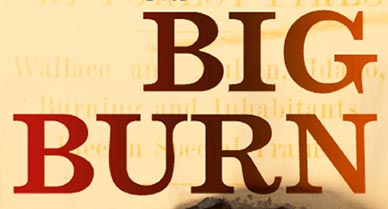I’m reading — via audiobook — a terrific book, The Big Burn: Teddy Roosevelt and the Fire that Saved America by Timothy Egan, about the biggest wildfire in US history, which in 1910 consumed 3 million acres in eastern Washington, Idaho, and Montana, destroying five towns and killing at least 85 people.
Narrative comes into play in the subtitle — the Fire that Saved America — in that, in the aftermath of the fire former president Teddy Roosevelt felt he must come up what author Egan calls a “master narrative” to garner popular support for the US Forest Service, the then-radical idea of conserving public lands, and ways of preventing and managing forest-fire threat.
Roosevelt, assisted by his close friend Gifford Pinchot, who had been the first head of the Forest Service but was fired by Roosevelt’s successor William Howard Taft, built this master narrative on what had transpired during and after the fire. A faction of lawmakers and businesspeople (who felt the forests’ resources should be exploited for commercial interests) had opposed the Forest Service and ensured that its funding was stripped to the bare bones. Consequently, rangers who played key roles in containing the fire got no sick leave and no assistance with medical expenses. No compensation was offered to families of those firefighters who lost their lives. Roosevelt told the story of the heroism of the rangers who fought walls of fire. He and Pinchot personalized the story of the fire, Egan writes. Particularly in a speech in Osawatomie, KS, Roosevelt (with speechwriting by Pinchot), told of the classic plotline, the “conflict between the men who possess more than they have earned and the men who have earned more than they possess…” (Read the text of the speech).
Leading the competing narrative was US Senator Weldon Brinton Heyburn, who blamed the Forest Service rangers for the fire and then, perpetuating a long tradition that continues today in the likes of Pat Robertson, said the fire was “God’s will” and that the deity obviously intended to clearcut all the trees from the forests.
In an interview with Smithsonian magazine, Egan tells how the fire — or more precisely, the “master narrative” Roosevelt and Pinchot told about it — “saved America:”
It saved America in this sense: it saved the public-land legacy. Now, people think public lands are national parks, but they’re really a small part of it. The Forest Service is the primary landlord of the American West. We have nearly 200 million acres of national forest land. At the time of this fire, Roosevelt had left office and Congress was ready to kill the Forest Service. So the fire had the ironic effect of saving the Forest Service, therefore saving America’s public-land legacy.
The fire and the master narrative not only saved the Forest Service but shaped its mission and “helped cement an antifire ideology in the Forest Service,” says John Galvin, writing about the fire as part of a list of 10 Worst Disasters of the Last 101 Years in Popular Mechanics (!). Galvin continues: “Congress poured money into the effort … The service created its own army to fight fires, replete with ground troops to dig trenches and set backfires, elite smoke jumpers to parachute into remote areas and an air force of tankers, reconnaissance planes and helicopters.”
Not only does Egan describe how storytelling changed public sentiment, but he engrossingly weaves the many stories of the fire and characters involved with it. I heartily recommend the book.
Read more about the fire and see pictures.
And here’s Egan talking about the fire and the book:
